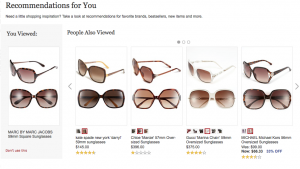A recent survey of online shoppers shows that consumers are more open to marketing personalization strategies than ever before. 79% of U.S. consumers expect personalization from brands, and over 50% expect e-commerce sites to remember past purchases. With these expectations and demands from the public, why hasn’t every company utilizing personalized marketing?
We’ve found that unwillingness to incorporate personalization comes down to one factor: Fear.
Fear of change
As marketing personalization is a relatively new concept, companies that are doing well without utilizing this marketing strategy may not want to make changes.
An article by Forbes explains why companies hesitate when making big changes.
Old habits act as a resistant towards change. These habits can be powerful and hard to break, pulling us away from new, alternative ideas. The brain is also responsible for resistance to change. One’s prefrontal cortex must work harder when experimenting with new ideas. With this in mind, companies may be reluctant toward embracing the new concept of personalization.
However, while embracing change may be difficult, doing so is imperative for a company that hopes to stay successful. Those who fail to utilize new approaches risk becoming outdated by competitors who conform to the fresh marketing tactics the public wants.
Fear of turning off customers
Personalized marketing is designed to give customers a 1:1 experience with products that are relevant and tailor-made for each individual. So why would some customers be turned off by this approach?
The creepiness factor.
Consider this blunder Target made a couple years ago. The company sent coupons for baby items to a teenage girl. Using the girl’s Guest ID number, name and historical buying data, Target had determined the girl was pregnant…however, the baby item coupons arrived in the mail before the girl had told her father. As chaos ensued, Target was met with skepticism. Critics called the company’s personalization practices “creepy” and “eerie.”
Situations like this give personalized marketing bad stigma. However, if the right precautions are taken, personalized marketing will not turn away customers.
Consider this: When a consumer is aware that their information is being tracked, they may be more comfortable sharing their data. Target had come across as invasive because neither the girl nor her family was aware that Target had been tracking her purchases and personal information.
Contrast this situation with a strategy employed by Nordstrom. Nordstrom uses marketing personalization by showing products similar to ones a customer has previously viewed. Because Nordstrom is so open about their use of personalization and data tracking, people are not fazed by it.

Rewards in exchange for information can help customers feel at ease with the creepiness factor. Reward customers for sharing their email information with special offers each month exclusively through email. Similarly, asking a customer for his or her date of birth can go from creepy to personal with the promise of a birthday card and special gift delivered during their special month.
While personalized marketing can admittedly come across as creepy, companies aware of the boundary between personal and invasive should not fear the concept of a personalized marketing campaign.
Fear of the payoff
If your company is spending money on personalizing an experience, will it pay off in the future? Or is your company wasting time, money and other resources on something that could end up costing more than its worth?
How can you be sure you’ll reach your desired return on investment?
Based on these statistics, we are confident that personalized marketing will generate positive results for companies. Personalization makes customers feel special, generates a higher response rate, strengthens loyalty, and increases customer lifetime value. Personalized emails in particular are able to generate 18 times more revenue, compared to generalized emails. 78% of CMOs believe that custom content is the future of marketing.
With so many positive effects from personalization, it’s difficult to imagine an unsatisfactory ROI after implementation. These stats should qualm any uneasiness about payoffs a company may have.
Key Takeaways:
While changing adding a personalization aspect to marketing campaigns may seem like a big leap of faith, doing so is more of a help than hinderance to companies. However, if used correctly, personalization gives your company the edge it needs to stay competitive, retain customers, and increase ROI. Need a few tips for getting started with personalizing your marketing strategies? We have determined four steps to implementing marketing personalization.

